Family Blenniidae: Isoginpo-ka
Aspidontus taeniatus taeniatus Quoy et Gaimard: Itohiki-kuroauji-ginpo
FUMT-P 4072, 4208.
Of three specimens collected from about one meter above the coral reefs in spring and summer, one was empty, whereas the other two (74 and 82 mm SL) contained fish scales and mucus (mean percentage of food volume: 60%) and unidentified material (40%) in the digestive tracts.
A. taeniatus taeniatus is well known to form a mimetic association with a cleaner labrid fish, Labroides dimidiatus, and to feed by tearing pieces from the fins of other fishes (e.g., Randall and Randall, 1960; Springer and Smith-Vaniz, 1972; Ehrlich, 1975; Smith-Vaniz, 1976). Hiatt and Strasburg (1960) reported, however, that three specimens of A. taeniatus taeniatus in the Marshall Islands had consumed shrimp fragments, fish eggs, and gurry, and concluded that it takes small crustaceans and fish, usually from living coral heads. Randall and Randall (1960) found that A. taeniatus taeniatus in Tahiti and Moorea had eaten sabellid worm tentacles and fish eggs in addition to pieces of the fins of other fishes. Despite its variable diet in other locations, however, we found only fish scales and mucus in the specimens from Minatogawa, and conclude that,
although other prey may be taken, A. taeniatus taeniatus on these reefs feeds mostly on fish skin.
Atrosalarias fuscus holomelas Günther: Indo-kaeruuo
FUMT-P 4068, 4209; 28 specimens; spring and summer; 27-68 mm SL; 1 empty.
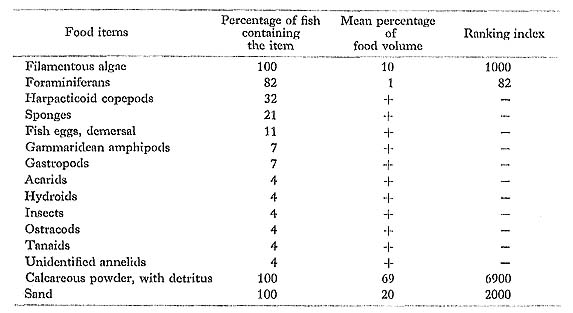
A. fuscus holomelas, which was the most common species of the blenniids on branching coral reefs at Minatogawa, fed mostly on filamentous algae and detritus, along with calcareous powder and sand. The various animal materials in the gut contents probably were taken incidentally when the fish scraped algae, its major food, from the surfaces of dead corals.
Exallias brevis (Kner): Sedaka-ginpo
FUMT-P 4210; 5 specimens; spring; 71-96 mm SL.

FUMT-P 4067; 5 specimens; summer; 75-92 mm SL.

E. brevis consistently occurs only on the reefs of living staghorn corals, especially Acropora, The gut contents differed between spring and summer: During the spring it fed primarily on scleractinian coral polyps and mucus (probably Acropora) along with calcareous powder, whereas in summer it consumed both scleractinian corals and fish eggs in about equal amounts.
Hobson (1974) reported that the major food item in all seven specimens of E. brevis in Hawaii (over 90% of the contents in each) was scleractinian corals, both tissue and mucus along with skeletal fragments, and the remaining food items were fine filamentous algae and diatoms. On the contrary, Hiatt and Strasburg (1960) found only fine filamentous algae and detritus in the single E, brevis from the Marshall Islands. Except for the fish eggs, the diet of E. brevis at Minatogawa was the same as that of the same species in Hawnii (Hobson, 1974). We thus conclude that E. brevis feeds by scraping coral polyps from the surfaces of living scleractinian corals (probably Acropora), although it may also take other prey.
Istiblennius bilitonensis (Bleeker): Hohoguro-ginpo
FUMT-P 4075.
A single specimen (82 mm SL), collected from the rocky reef in summer, had fed on filamentous algae (percentage of food volume: 40%), foraminiferans (2%), harpacticoid copepods (+), calcareous powder with detritus (43%), and sand (15%).
We frequently observed this species scraping the surfaces of coral rocks with its comb-like teeth.
Istiblennius periophthalmus (Valenciennes): Hana-kaeruuo
FUMT-P 4076; 1 specimen; summer; 87mm SL.
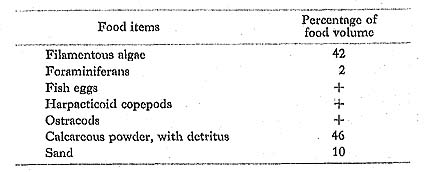
I. periophthalmus, collected from the rocky reef, had taken mostly filamentous algae
and detritus, along with calcareous powder and sand. We observed it actively scraping the surfaces of coral rocks with its comb-like teeth, like I. bilitonensis.
Meiacanthus kamoharai Tomiyama: Kamohara-ginpo
FUMT-P 4069, 4211; 11 specimens; spring and summer; 37-63 mm SL.

Most of the prey of M. kamoharai were small benthonic invertebrates and filamentous algae.
Petroscirtes breviceps (Valenciennes): Niji-ginpo
FUMT-P 4070; 2 specimens; summer; 53 and 55 mm SL.
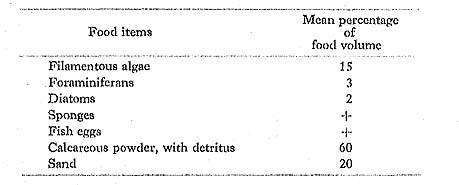
P. breviceps had taken mainly filamentous algae and detritus, along with calcareous powder and sand.
Petroscirtes mitratus Rüppell: Hatatate-ginpo
FUMT-P 4071; 3 specimens; summer; 36-51 mm SL.

P. mitratus, collected from an algal belt of Hydrochavitaceal spp. in a shallow sandy area, had eaten mostly filamentous algae and detritus, along with calcareous powder and sand.
Plagiotremus rhinorhynchos (Bleeker): Minami-ginpo
FUMT-P 4212.
A single specimen (65 mm SL) was collected from about one meter above the coral reef in spring. Its major food item was fish scales and mucus (percentage of food volume: 98%), and the remaining item was fish eggs. These food data suggest that this species is a fish skin-feeder, like Aspidontus taeniatus.
Springer and Smith-Vaniz (1972) and Losey (1972) reported that two congeners, P. townsendi and P. laudandus, form mimetic complexes with species of two other blenniid genera, Meiacanthus and Ecsenius, and tear scales and mucus from the bodies of other fishes.
Plagiotremus tapeinosoma (Bleeker): Tenkurosuji-ginpo
FUMT-P 4213.
Of five specimens collected from about one meter above the coral reefs in spring, two had empty guts, while the other three (60-75 mm SL) had eaten fish scales and mucus (mean percentage of food volume; 60%), cyclopoid copepods (30%), errant polychaetcs (9%), filamentous algae (1%), and harpacticoid copepods (+).
Russell et al. (1976) observed that P. tapeinosoma enters into loose mimetic relationships with three other fishes, Thalassoma amblycephalus (Labridae), Trachinops taeniatus (Plesiopidae), and Forsterygion sp. (Tripterygiidae), and feeds entirely on the mucus and skin of other fishes. Their observation and our gut content analysis indicate that P. tapeinosoma, like P. rhinorhynchos, feeds on the skin, scales, and mucus of other fishes, although it may also take other prey.
Salarias fasciatus (Bloch): Yacyama-ginpo
FUMT-P 4047, 4214; 12 specimens; spring and summer; 33-117 mm SL; 1 empty.
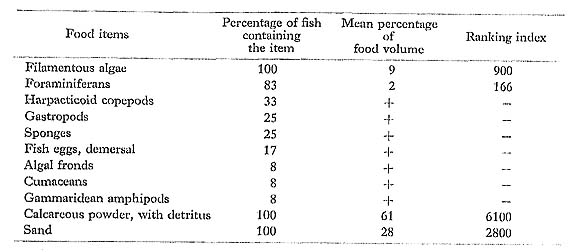
S. fasciatus, which commonly occurs on rocky and branching coral reefs at Minatogawa, fed mostly on filamentous algae and detritus, along with large amounts of calcareous powder and sand. We observed it actively scraping the surfaces of coral rocks and dead coral skeletons with its comb-like teeth. The various animal materials among its gut contents probably were taken incidentally.
Salarias luctuosus Whitley: Shima-ginpo
FUMT-P 4073; 4 specimens; summer; 57-70 mm SL.

All specimens were collected from intertidal pools 30-50 cm in depth, and their gut contents suggest that this species, like S. fasciatus, scrapes its food from the surfaces of coral rocks.
Family Gobiidae: Haze-ka
Acentrogobius cauerensis (Bleeker); Omon-haze
FUMT-P 4086; 1 specimen; summer; 47 mm SL.
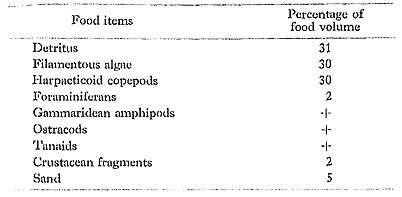
In addition to detritus and filamentous algae, this species had fed heavily on demersal planktonic crustaceans.
Amblygobius albimaculatus (Rüppell): Sarasa-haze
FUMT-P 4079, 4198; 19 specimens; spring and summer; 42-92 mm SL.

A. albimaculatus occurs in sandy areas around the coral reefs and constructs burrows in the sand. On the approach of danger this species retreats to its burrow and, if the threat intensifies, dives immediately into it.
In addition to filamentous algae, A. albimaculatus had preyed heavily on demersal planktonic crustaceans.
Amblygobius hectori (Smith): Kinsen-haze FUMT-P 4199.
A single specimen (34 mm SL) was collected in spring close to the bottom of the outer reef flat margin. Its major food item was filamentous algae (percentage of food volume: 95%), but it also took copepods (5%) and tanaids (+).
Asterropteryx semipunctatus Rüppcll: Hoshi-haze
FUMT-P 4080, 4200; 9 specimens; spring and summer; 29-39 mm SL.
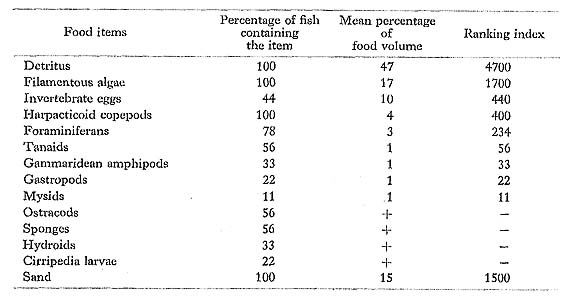
A. semipunctatus had fed on detritus, fine filamentous algae, and various small invertebrates. Dotu and Mito (1963) found mostly epiphotic diatoms, Coscinodicus spp., in the diet of the same species from southern Japan.
Bathygobius fuscus (Rüppell): Kumo-haze
FUMT-P 4087.
Two specimens (56 and 61 mm SL) collected in summer contained grapsid crabs (mean percentage of food volume: 50%), unidentified craba (45%), and filamentous algae (5%) in the digestive tracts.
Dotu (1955), who examined in detail the life history of B. fuscus (as Gobius poecilichthys) in Amakusa, Japan, found small crustaceans, chitons, and gastropods in the diet of the adult fish. Hiatt and Strasburg (1960) reported that this species (as B. fuscus fuscus) in the Marshall Islands is a carnivore feeding mostly on benthonic small animals, including crustaceans, polychaetes, fishes, and insects, although it occasionally scrapes off some algal fragments.
Callogobius hasseltii (Bleeker): Okinawa-haze
FUMT-P 4081, 4201; 5 specimens; spring and summer; 33-48 mm SL.
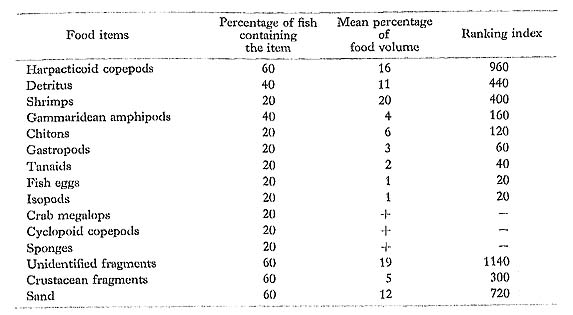
C. hasseltii had taken mostly demersal planktonic crustaceans and other small benthonic invertebrates.
Eleotriodes longipinnis (Lay et Bennett): Sazanami-haze
FUMT-P 4078, 4202; 11 specimens; spring and summer; 83-143 mm SL.
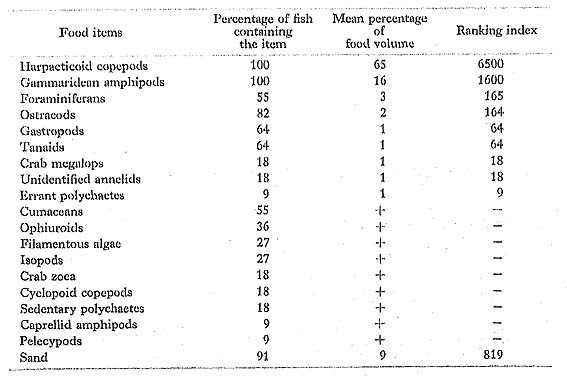
E. longipinnis usually occurs in sandy areas around the coral reefs and constructs bur
rows in the sand. On the approach of danger this species retreats to its burrow and, if the clanger intensifies, dives immediately into it.
E. longipinnis at Minatogawa had eaten chiefly demersal planktonic crustaceans. We frequently observed this species fillings its mouth with sand and ejecting it from the mouth or through the gill openings. These food data and observations clearly suggest that E. longipinnis feeds mostly on demersal planktonic crustaceans hiding in the sand during the day.
Fusigobius neophytus (Glinther): Sankaku-haze
FUMT-P 4082, 4203: 8 specimens; spring and summer; 30-48 mm SL; 1 empty.

F. neophytus had taken a variety of small invertebrates, along with some amounts of detritus.
Gnatholepis sp.
FUMT-P 4083; 3 specimens; summer; 41-42 mm SL.
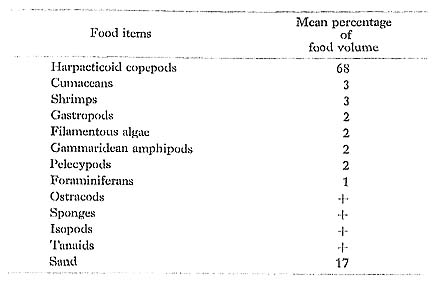
The body form and coloration of the three specimens collected from sandy bottoms just beneath the coral colonies coincide well with those of Gnatholepis sp. which was recorded by Hayashi and Itoh (1978: Pl. 16, Fig. 50). Moat of the prey of this species were demersal planktonic crustaceans.
Gobiodon citrinus (Rüppell): Koban-haze
FUMT-P 4077, 4204; 36 specimens; spring and summer; 27-37 mm SL; 5 empty.

G. citrinus had taken predominantly scleractinian coral polypa and mucus (probably Acropora), with no calcareous powder.
Tyler (1971) reported that four species of the genus Gobiodon in the Great Barrier Reef mostly inhabit branching Acropora shrub corals. At Minatogawa we also consistently observed G. citrinus on branching Acropora. Based on our gut content analysis, therefore, the coral-dwelling habit of this species is due to its food preferences.
In contrast, although Hiatt and Strasburg (1960) found that two congeners, G.erythrospilus and G.rivulatus, live exclusively in living heads of branching corals (Pocillopora sp., Acropora sp., and Stylophora sp.) in the Marshall Islands, they reported only small crustaceans, polychaetes, and fish eggs in their diets.
Istigobius spence (Smith): Hime-kazari-haze
FUMT-P 4085, 4197; 3 specimens; spring and summer; 38-41 mm SL.
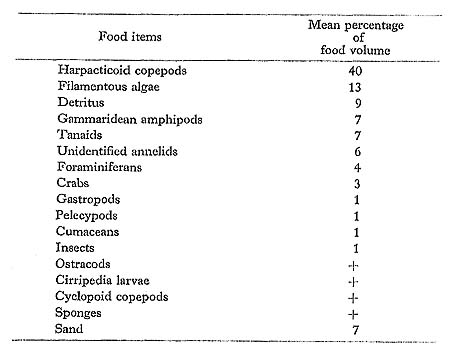
Demersal planktonic crustaceans and filamentous algae were the major items in the gut of I. spence at Minatogawa.
Macrodontogobius wilburi Herre: Madara-haze
FUMT-P 4084; 2 specimens; summer; 41 and 47 mm SL.
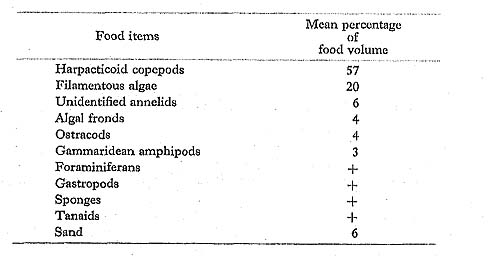
M. wilburi had taken mainly demersal planktonic crustaceans and filamentous algae.
Ptereleotris evides (Jordan et Hubbs): Kuroyuri-haze
FUMT-P 4089, 4205; 23 specimens; spring and summer; 36-62 mm SL.

P. evides, which usually hovered in small schools of up to ten or more individuals over the reefs, fed on small planktonic crustaceans, especially copepods.
Ptereleotris microlepis itomanensis Aoyagi: Itoman-kuroyuri-haze
FUMT-P 4090, 4206; 12 specimens; spring and summer; 42-66 mm SL.

Like P. evides, P. microlepis itomanensis generally occurred in schools over the reefs, where it took small planktonic crustaceans, especially calanoid copepods.
Ptereleotris microlepis sakurai (Schmidt): Sakurai-kuroyuri-haze
FUMT-P 4088; 2 specimens; summer; 62 and 65 mm SL.
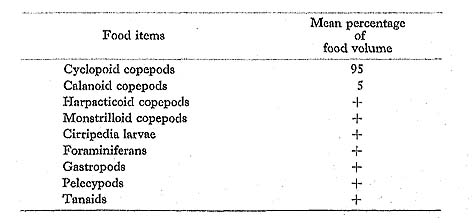
P.microlepis sakurai had taken small planktonic crustaceans, especially cyclopoid copepods.





















